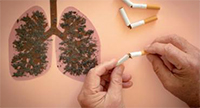Tobacco and lung cancer
Smoking is the number one preventable cause of premature death. One in two smokers who smoke throughout their life dies of a disease related to this consumption. In pneumology, two of the main pathologies, chronic obstructive pulmonary disease and lung cancer, are due in approximately 80 to 90% of cases to tobacco consumption.
Lung cancer is the set of malignant tumors originating in the bronchial or bronchopulmonary level. The incidence and mortality are very close, which testifies to the poor prognosis of this disease.
In Tunisia, the incidence of PBC in humans is 20.8/100,000 inhabitants. In 2016 and according to the cancer registry of the A. Mami hospital in Ariana, 463 new cases of lung cancer were listed with an average age of 62.5 years and a sex ratio M/F of 8.5 .
Given the “modest” effectiveness of the treatments available for this disease, the treatment of tobacco dependence must be a common objective for general practitioners and specialists, in particular pulmonologists.
The cigarette remains currently in the world the mode of consumption of tobacco the most widespread and the most effective as regards the delivery of nicotine; its toxicity to health, due to the combustion of tobacco, is well established, whether for active smoking or for passive smoking; all forms of smoked tobacco (rolling tobacco, cigars, cigarillos, shisha, etc.) are toxic. The toxicity of new forms of tobacco sold such as heated tobacco is currently unknown.
There are several currents of smoke: the main current (primary) which corresponds to the smoke directly inhaled by the smoker, opposed to the side current (secondary), which corresponds to the smoke produced by a cigarette burning alone in the absence of smoker's inhalation. This lateral current, associated with the tertiary current (smoke exhaled by the smoker, the latter having been largely “filtered” in the lungs), is at the origin of environmental passive smoking.
The risk of lung cancer is mainly a function of the duration of smoking. For an equal total amount of smoked tobacco, the annual risk is multiplied by 20 when the duration of consumption increases from 15 to 30 years.
The management of smoking is required of all health professionals according to their competence.
- The first role of the doctor is to develop the motivation of the smoker towards an attempt to quit.
- The smoker's motivation is a determining factor in initiating and maintaining withdrawal, this must be assessed and reinforced throughout the follow-up.
- The management of smoking is not limited to a pharmacological prescription but must also offer regular long-term monitoring.

RELATED PRODUCTS
- PACLITAXEL / Carcinology

- PACLITAXEL / Carcinologie

- ABIRATERONE ACETATE / Carcinology

- ABIRATERONE ACETATE / Carcinologie

- IMATINIB / Hematology

- IMATINIB / Hématologie

